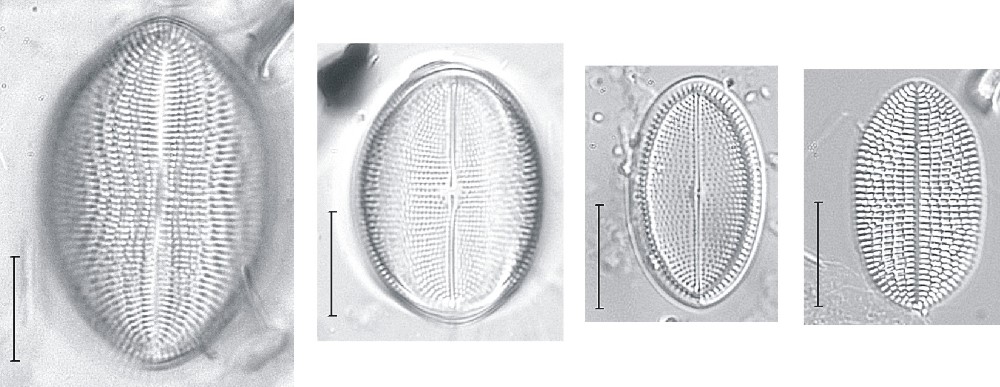Cocconeis C.G. Ehrenberg; 1837; 173
Key references
Jahn R., Kusber W.-H., Romero O.E. 2009. Cocconeis pediculus EHRENBERG and C. placentula EHRENBERG var. placentula (Bacillariophyta): Typification and taxonomy. Fottea. 9(2): 275-288.
Morphology
Cells discoid, elliptical or almost circular in valve view, with smoothly rounded or slightly pointed poles. Girdle very narrow and cells therefore almost always lying in valve view.
Frustules heterovalvar, one valve with a raphe system the other without (i.e. frustules ‘monoraphid’), usually isopolar (though the outline is frequently slightly irregular, as a result of malformations occurring during cell division); raphe valve concave, rapheless (pseudoraphe) valve convex.
The raphe and rapheless valves differ clearly in ornamentation. Often the raphe valve has finer and the rapheless valve coarser striae. Striae usually uniseriate, sometimes interrupted by lyre-shaped plain areas, or (raphe valves) by a plain (hyaline) ring running submarginally around the whole perimeter of the valve. Areolae circular to transapically elongate, sometimes loculate (in the rapheless valve), occluded by fine pore plates (hymenes).
Raphe valve with a linear axial area and often a small central area. Rapheless valve with linear or lanceolate axial area of varying width. Raphe and pseudoraphe usually central throughout, but sometimes sigmoid or lying obliquely; external central and polar raphe endings simple or expanded; internal central endings deflected in opposite directions.
A few open girdle bands per theca. A single C-shaped chloroplast, which can be very elaborately lobed (each lobe containing a pyrenoid) lying under the araphid valve.
Solitary, tightly appressed to a solid substratum, to which it is attached by mucilage produced by the raphe valve.
Frustules heterovalvar, one valve with a raphe system the other without (i.e. frustules ‘monoraphid’), usually isopolar (though the outline is frequently slightly irregular, as a result of malformations occurring during cell division); raphe valve concave, rapheless (pseudoraphe) valve convex.
The raphe and rapheless valves differ clearly in ornamentation. Often the raphe valve has finer and the rapheless valve coarser striae. Striae usually uniseriate, sometimes interrupted by lyre-shaped plain areas, or (raphe valves) by a plain (hyaline) ring running submarginally around the whole perimeter of the valve. Areolae circular to transapically elongate, sometimes loculate (in the rapheless valve), occluded by fine pore plates (hymenes).
Raphe valve with a linear axial area and often a small central area. Rapheless valve with linear or lanceolate axial area of varying width. Raphe and pseudoraphe usually central throughout, but sometimes sigmoid or lying obliquely; external central and polar raphe endings simple or expanded; internal central endings deflected in opposite directions.
A few open girdle bands per theca. A single C-shaped chloroplast, which can be very elaborately lobed (each lobe containing a pyrenoid) lying under the araphid valve.
Solitary, tightly appressed to a solid substratum, to which it is attached by mucilage produced by the raphe valve.
Literature
References are given in chronological order.
Reference |
Citation |
|---|---|
| Ehrenberg C.G. 1837. Zusätze zur Erkenntnifs großer organischer Ausbildung in den kleinsten thierischen Organismen. Abhandlungen der Königlichen Akademie der Wissenschaften zu Berlin 1835. 151-180 pp; 1 pl. | Morphology; Taxonomy; Description |
| Ehrenberg C.G. 1838. Die Infusionsthierchen als vollkommene Organismen. Ein Blick in das tiefere organische Leben de Natur. Verlag von Leopold Voss, Leipzig. 1-xvii, 1-548 pp; 1-64 pls | Morphology |
| Geitler L. 1927. Somatische Teilung, Reduktionsteilung, Copulation und Parthenogenese bei Cocconeis placentula. Archiv für Protistenkunde. 59: 506-549. | Biology |
| Romero O.E. 1996. Ultrastructure of four species of the diatom genus Cocconeis Ehr. with the description of C. pseudocostata sp. nov. Nova Hedwigia. 63: 361-396. | Morphology; Illustrations |
| Jahn R., Kusber W.-H., Romero O.E. 2009. Cocconeis pediculus EHRENBERG and C. placentula EHRENBERG var. placentula (Bacillariophyta): Typification and taxonomy. Fottea. 9(2): 275-288. | Morphology; Type Illustration; Taxonomy; Description; |
| Leterme S.C., Ellis A.V., Mitchell J.G., Buscot M.-J., Pollet T., Schapira M., Seuront L. 2010. Morphological flexibility of Cocconeis placentula (Bacillariophyceae) nanostructure to changing salinity levels. Journal of Phycology. 46: 715-719. | Illustrations; Biology; Morphology |
| Romero O.E., Jahn R. 2013. Typification of Cocconeis lineata and Cocconeis euglypta (Bacillariophyta). Diatom Research. 28(2): 175-184. | Morphology; Taxonomy; Type Illustration; Description |
This page should be cited as:
Mann D. G., Jüttner I. Cocconeis C.G. Ehrenberg; 1837; 173. In: Jüttner I., Carter C., Cox E.J., Ector L., Jones V., Kelly M.G., Kennedy B., Mann D.G., Turner J. A., Van de Vijver B., Wetzel C.E., Williams D.M..
Freshwater Diatom Flora of Britain and Ireland. Amgueddfa Cymru - National Museum Wales. Available online at https://naturalhistory.museumwales.ac.uk/diatoms/browsespecies.php?-recid=3938. [Accessed:
].
Record last modified: 27/12/2020


